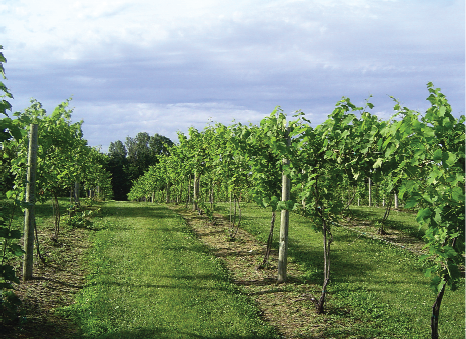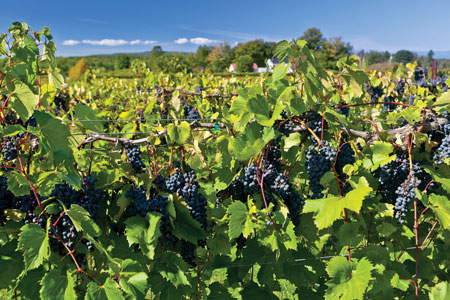
Indeed, for 4–6 months of the year, the frigid and snowy landscape hardly seems like a great place to plant a vineyard. Temperatures in January and February drop sufficiently low to kill dormant buds in most cultivated grapevines. Nonetheless, our best kept secret is our mild summers marked by long warm days and cool nights. Many grape varieties can ripen in Minnesota – they just need to be buried for winter protection!
Although grapes have been grown in the Upper Midwest and northeastern parts of the US for at least 150 years, the availability of refrigerated rail cars and trucks in recent years have made it easy for northern winemakers to purchase grapes, must and juice concentrate from warmer climates. Those wishing to use local produce often make wine from fruits such as apples, raspberries or rhubarb. However, with help from the breeding expertise at the University of Minnesota, northern winemakers now have the possibility to make high-quality wine from cold-climate grapes grown right in their own backyard!
In 1908, when the Horticulture Research Center (HRC) in Excelsior, Minnesota was created, the goal was to create many different types of fruit crops that could survive the frigid temperatures of the Upper Midwest. Although the University of Minnesota is internationally famous for developing high-quality, cold-hardy apples, few people realize that grapes have been part of the fruit-breeding program at the HRC from the very beginning. One of the foundation cultivars used in the HRC’s breeding stock, Beta, was developed in Minnesota, in 1881, by private breeder Louis Suelter. It was widely planted in Minnesota at the turn of the 20th Century, and was one of the first true cold-hardy grape cultivars. Cold-hardy grapes have buds that will survive without winter protection in regions that would be classified as 4a and 4b on the USDA hardiness zone map. In addition to surviving harsh winters, they also will ripen in a short growing season of about 145–160 frost-free days, and 2,000-2,500 growing degree days at a base of 50 °F (10 °C).
Unfortunately, with the onset of the temperance movement and Prohibition, a public breeding program for wine grapes fell by the wayside, and the development of a northern wine industry was put on hold. It wasn’t until a dairy farmer and amateur grape breeder by the name of Elmer Swenson started breeding grapes on his farm in Osceola, Wisconsin that the idea of northern vineyards started to take off. Swenson used an unnamed Minnesota selection, known simply as MN 78 (a cross of Beta and Witt) as one of the foundations of his breeding work starting in the 1940s. In the 1970s, at the age when most people retire, he was hired by the University of Minnesota and continued his grape breeding while working as a gardener at the HRC. In 1978, the University of Minnesota and Swenson co-released two varieties of table grapes: Edelweiss and Swenson Red. The early success of Swenson hybrids in Minnesota further pushed the development of wine grape varieties. A full-time grape breeder, Peter Hemstad, was hired in 1985 and continues to run the breeding program today. Now with nearly 10 acres of research vineyards along with a research winery built in 2000 and a full-team of educated vineyard staff and enologists, the University of Minnesota is at the forefront of advanced grape-breeding for cold-climate regions.
Each spring, pollen is collected from the flowers of “father” vines that are grown in our greenhouse. These are often promising selections from our breeding program, but use of non-hardy vines like Pinot Noir or Cabernet Sauvignon also contribute to the breeding stock. Just before the flowers open on the “mother” vine, the male part of the flower is removed in order to prevent self-pollination, and the pollen previously collected is used to pollinate the flower. Timing is critical to ensure that no cross-pollination occurs. The entire flower cluster is then covered and sealed with a paper bag and the fruit is left to ripen on the vine. This process is repeated on 30–50 different vines throughout the vineyard during flowering. At the end of the growing season, the bagged grape bunches are collected, and the seeds are harvested. Approximately 5,000 seedlings are grown each spring in the greenhouse. They are then planted in our nursery plot where they undergo intensive evaluation for desirable traits. Those that don’t meet certain standards are culled from the breeding program. Many are lost in the first year, and by the 3rd–5th year of growth, only 20–30 of these vines show enough promise in the vineyard to begin vinification trials.
Individual vines primarily must prove to be both cold-hardy and disease resistant. If they can’t survive winter in Minnesota, they are removed from the breeding program. Other traits such as flower type, growth habit, time of flowering and ripening characteristics of the fruit are also evaluated in the first few years of growth. Berry size, cluster formation and yield are also important characteristics of the fruit, in addition to evaluating the flavor of grapes. Chemical analysis of sugars and acids will also be performed early-on in fruit production, and “nano”-vinification trials may be performed to get an early idea of wine chemistry. We may only be able to ferment a few liters of juice from these single-vine trials. In these early stages, vines that are very promising are selected, meaning that we assign them a number (such as MN 1211), and they are propagated so we may perform micro-vinification trials. All wines in the early test stages undergo a standardized winemaking procedure for comparison purposes. A grape that shows promise in the standardized vinification trials will undergo winemaking optimization trials, so we may have a better idea of how different winemaking techniques such as maceration time or yeast selection may enhance or diminish the quality of the resulting wine. Optimization trials may continue for many years before a grape is named and released to the public.
In 1996, the University released its first wine grape cultivar with Frontenac. A light-bodied, fruity red wine with bright cherry and blackberry aromas, it lacks the “foxy” character associated with many hybrid grapes. Although it has been made successfully in a variety of different wine styles, it seems to do best as a rosé or dessert/Port-style wine. Since the release of Frontenac, the University has developed and released three more wine grapes: La Crescent (2002), Frontenac Gris (2003), and Marquette (2006). All have had success in commercial wineries, winning numerous awards in competitions across the United States. Each grape has unique characteristics and the potential to make interesting wines.
The Frontenac “family” of grapes includes Frontenac, Frontenac Gris, and most recently, Frontenac Blanc. It turns out that the Frontenac genetics are relatively unstable, and therefore the vine has a tendency to undergo single-bud mutations. The first mutation from “noir” to “gris” was discovered in the vineyard at the HRC. Frontenac is a teinturier variety, meaning that the skin and the pulp of the berry contain dark pigments (anthocyanins). In Frontenac Gris, the skin is much less pigmented, and the pulp contains no red color. A third mutation, Frontenac Blanc, resulted in a grape that is completely colorless. This is the same series of mutations that occurred in the more well-known Pinot “family” of Pinot Noir, Pinot Gris and Pinot Blanc.
While color is certainly one difference among the Frontenac cultivars, they also have unique aromatic profiles. While Frontenac leans toward aromas of bright cherry and dark berry fruits, Frontenac Gris is reminiscent of ripe peaches and apricots. Although we’re just beginning to characterize Frontenac Blanc, it seems to lean toward a tropical fruit nose of pineapple and citrus fruits. It has also been noted as being slightly herbaceous with grassy and pine notes. However, it should be noted that the blanc mutation has occurred in more than one vineyard, so it is difficult to say if each clone of Frontenac Blanc will share identical aroma characteristics.
Enologically, all of the Frontenac cultivars are prone to high sugar and total acidity levels, so they require some skill in order to make them into a palatable dry wine. Normal °Brix readings at harvest are between 24 and 28, though they can climb as high as 30. Average total acidity is 15 g/L, with an average pH of 3.0. Because of their high natural acidity and sugar, all are very well suited for dessert-style wines. Frontenac Gris makes an excellent ice wine, and also makes a lovely Port-style wine. With some maceration on the skins, it also makes an excellent rosé. One of the strengths of Frontenac is its versatility. Knowledge of deacidification techniques is necessary to make a dry wine. Frontenac is also the easiest of the UMN cultivars to grow. It is an extremely vigorous and hardy grape that requires little to no spraying to prevent disease issues – perfect for the backyard grower wary of chemical sprays near their home.
The first white grape cultivar released by the university, La Crescent, is a wonderfully aromatic grape. It makes a white wine not unlike many Germanic wines such as Riesling or Gewürztraminer. Its parentage includes the popular Swenson cultivar, St. Pepin, along with another Swenson selection containing Muscat Hamburg. The result is a grape that can have heady white floral or Muscat aromas, along with tropical fruit flavors, peach and mango. While it still is prone to high acidity (averaging around 13 g/L), it is a bit more manageable than Frontenac. Much like Riesling, it is extremely versatile in the winery. It makes crisp and refreshing wines on the dry-side, mouth-watering dessert wines with a good acid backbone and everything in-between. Recently, some experimentation with pre-fermentation maceration have shown promising results.
Although the vine is only moderately resistant to powdery mildew, a good spray program ensures no disease issues during the growing season. Fruit left to hang late in the season also can have a tendency to shell on certain vineyard sites or in certain years, though the exact cause of this phenomenon is unknown. Thus, while La Crescent makes an excellent wine, it is not for the beginning grower.
The latest grape developed by the University of Minnesota, Marquette, is garnering lots of excitement. A grandson of Pinot Noir, and a cousin of Frontenac, it shares many of their positive traits. A fairly vigorous vine, it shows very good resistance to powdery and downy mildew as well as black rot. Like Frontenac, little to no spraying is necessary against diseases. In the winery Marquette shines as a dry red table wine. Although the total acidity can still be fairly high (averaging around 12 g/L), most years all that is needed is simply to put the wine through malolactic fermentation and cold-stabilization to soften the acidity. The finished wine displays complex aromas of dark berry fruits coupled with black pepper, spices, and sometimes leather. Marquette is naturally very low in tannin. Good tannin structure is found with a maceration time of 7–8 days during fermentation.
Extended maceration on the skins doesn’t seem to improve tannin structure, thus addition of enological tannins or barrel aging is beneficial to improve the mouthfeel. However, its light structure and delicate nose can be overpowered by heavy toast and new oak. Commercial wineries are experimenting with different coopers and types of oak to determine the ideal oak program. Because Marquette vines were just released in 2006, we are only beginning to see how well it performs in commercial wineries. Some of the obstacles to overcome in the winery are a tendency toward a higher pH in some years, as well as high potential alcohol (>14%), with average °Brix at harvest around 25. Regions with a more moderate climate than Minnesota may want to consider growing Marquette to use as a blending grape in vintages with less-than-ideal ripening conditions for traditional cultivars. Marquette also has the advantage of being a teinturier variety, so it rarely has issue with obtaining sufficient color. Its color also tends to lack the inkiness seen in other hybrid grapes. Marquette has certainly raised the bar in terms of the quality of grape that can be utilized in northern climates. However, we are always eagerly anticipating what the new season will bring. The next cold-hardy grape may have yet to bear its fruit. For more information check out our websites at http://grapes.umn.edu and http://enology.umn.edu.
Frontenac (image 1), Frontenac Gris (image 2) and La Crescent (image 3), three cold-hardy grapes released by the breeding program at the University of Minnesota. In winter, these vines are resistant to bud damage due to cold temperatures. And, they will fully ripen in the shortened, northern growing season. Harvest numbers for Frontenac grapes are typically on the high side for both sugars and acids.
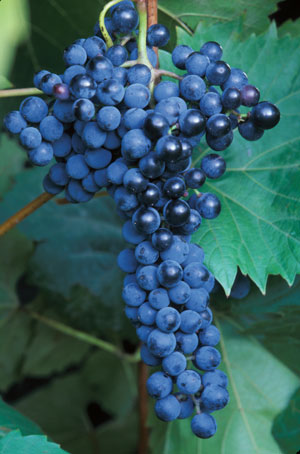
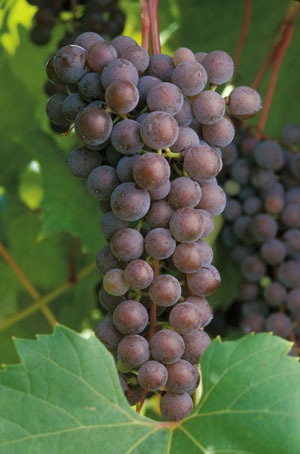
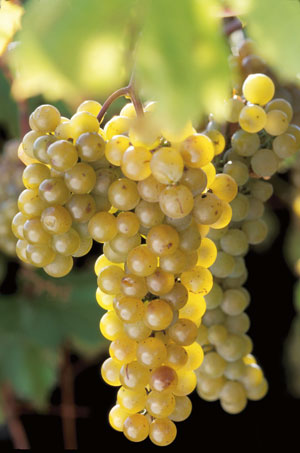
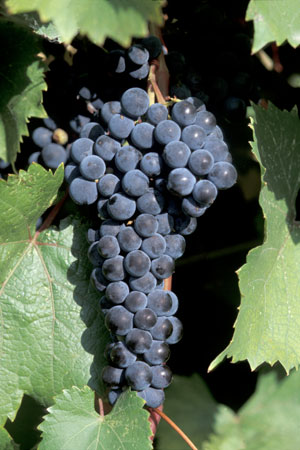
Commercial wineries are still exploring their options with these cold-hardy grapes. The high-sugar, high-acid Frontenac family of grapes are often used for dessert wines. La Cresent is a versatile white grape, along the lines of Riesling, and can be made into a variety of styles. Marquette — the newest of the U of M releases — can be made into a dry red and works well with oak (image 4).
Marquette: A Pro’s Perspective
In the years since it was released (in 2006), Marquette has taken the world of cold climate viticulture by storm . When the wine is well made, it doesn’t really taste like a hybrid wine. It has a depth, complexity of flavor, tannins and finish more typical of a vinifera wine. When you add to that the fact that the vines are reliable, productive and very manageable, you have a great combination.
I like to train Marquette vines on a high wire and position the shoots downward as they grow. I use both a single wire and a Geneva Double Curtain training system. The choice between them depends on soil fertility: the more fertile the soil, the bigger the trellis. In early to mid-summer, we work though the vineyard positioning the shoots downward. This is a tedious job, but the results are worth it. We end up with nice compact fruit zone at about shoulder height, with good sun exposure. In late summer, we go through the vineyard again, pulling leaves around the clusters to open them up to the sun. We also do our cluster thinning at this time. We remove any more than two clusters per shoot, and any clusters that are lying on top of each other. If we can time this job soon after veraison, we also take off any still-green clusters. When we do it all right, fruit is all at the same level, well-exposed, and uniform.
Marquette vines have fairly good disease resistance and a moderate spraying program will keep them clean. They are somewhat susceptible to foliar phylloxera, so this is one problem to keep an eye out for.
There is some disagreement among winemakers as to the best harvest parameters for Marquette. Fully mature, it will top out at about 25 °Brix, and about 10–11 grams of acid per liter, and a pH of about 3.2. These are the conditions of the grapes from which I’ve made my best wine. But there are some good winemakers who argue that it should be picked a little earlier, around 23 °Brix, and a pH of about 3.0. Their argument is that Marquette has an unusually high proportion of malic to tartaric acid, and that wine from fully ripe grapes will actually be too low in acid once the malolactic fermentation has used up all the malic acid. I haven’t seen this problem in my own wine, but I have tasted examples of flat, flabby Marquette. My strategy is to try to pick fully mature grapes, but to wait until after malolactic fermentation before doing any chemical adjustment of acids. There is also no consensus about the best yeast to use with Marquette. The best Marquette wine I’ve tasted was made with good old Pasteur Red. I tried a batch with Pasteur Red this year, and while it’s still in the barrels, it’s showing good promise. I also like a batch I made with CSM yeast. I try to get all the oxygen I can to the wine during primary fermentation. I splash the wine into a pan from the racking valve on my tanks, then pump it over the cap from there. I even use a Venturi injector — sucking nothing but air — on the hose I use to pump over.
I like to inoculate with malolactic bacteria at about one-third sugar depletion, when the wine is still nice and warm from the fermentation. The MLF usually takes off and finishes in good time. I used to inoculate after primary fermentation was finished, but by that time the wine, and the winery, were cooling down and I struggled to the get the MLF complete. I choose a strain of bacteria like MBR 31 that is adapted to low pH, and lower temperatures.
Marquette wine takes very well to barrel aging. I’ve used only American oak, but I feel that French oak barrels would work very nicely with Marquette. I’ve aged the wine for about 9 months in the barrels, though I have to admit that this time period is more of a business decision than a winemaking one.
When it’s handled right, this is the grape that allows growers in northern areas to make a red wine that can hold a place with wines from warmer, sunnier climes.
– Chris Granstrom, Lincoln Peak Vineyard, Vermont
